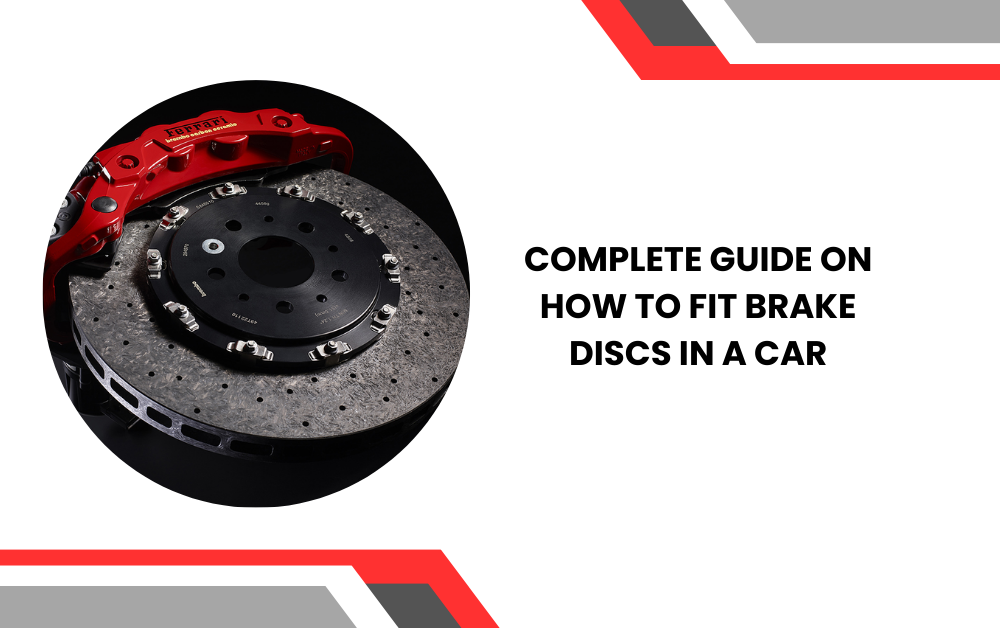Introduction to Brake Discs
Brake discs are a crucial part of a car’s braking system, responsible for slowing down or stopping the vehicle. Properly fitting brake discs is essential for ensuring the safety and performance of your car. This guide will walk you through the process of fitting brake discs in a car, highlighting the tools you’ll need, the steps to follow, and important tips to ensure a successful installation.
Tools and Materials Needed
Before starting the brake disc fitting process, gather all the necessary tools and materials. You will need a jack and jack stands, a lug wrench, a torque wrench, a brake caliper tool, a screwdriver, a rubber mallet, brake cleaner, and new brake discs and pads. Having all these tools ready will make the process smoother and more efficient. Ensure that you have a safe and spacious working area where you can comfortably carry out the task without any interruptions.
Preparing the Vehicle
Safety First
Safety is paramount when working on your car. Start by parking your car on a level surface and engaging the parking brake. Wear safety gloves and goggles to protect yourself from dust and debris. Use wheel chocks to prevent the car from moving while it is lifted. It’s crucial to follow all safety precautions to avoid any accidents or injuries during the process.
Lifting the Car
Using a jack, lift the car and secure it with jack stands. Make sure the car is stable and won’t move during the installation process. This step is essential to access the wheels and brake discs safely. Double-check the stability of the car before proceeding to the next step.
Removing the Wheel
Use a lug wrench to loosen the lug nuts on the wheel. Once the lug nuts are loose, remove them completely and take off the wheel. Set the wheel aside in a safe place. This will expose the brake caliper and disc, allowing you to start the replacement process.
Removing the Old Brake Discs
Accessing the Brake Caliper
Locate the brake caliper, which is the component that holds the brake pads against the disc. Use a screwdriver to remove the caliper bolts, being careful not to damage any components. Once the bolts are removed, carefully lift the caliper off the disc and secure it with a piece of wire to prevent it from hanging by the brake line. This step is crucial to avoid putting stress on the brake hose.

Removing the Brake Pads
With the caliper out of the way, remove the old brake pads. These should come out easily, but if they are stuck, gently pry them loose with a screwdriver. Set the old pads aside, as you will be replacing them with new ones. Inspect the pads for uneven wear, which could indicate other issues in the braking system that need to be addressed.
Taking Off the Old Brake Disc
The brake disc should now be exposed. In some cases, the disc may be held in place with retaining screws. Use a screwdriver to remove these screws. If the disc is stuck due to rust or debris, use a rubber mallet to gently tap around the edges until it comes loose. Carefully remove the old disc and set it aside. Clean the hub area to ensure a smooth surface for the new disc.
Installing the New Brake Discs
Preparing the New Disc
Before installing the new brake disc, clean it with brake cleaner to remove any protective coating or debris. This step is important to ensure optimal performance and prevent contamination of the brake pads. Make sure the new disc is compatible with your car’s make and model.
Mounting the New Brake Disc
Align the new brake disc with the wheel hub and slide it into place. If the disc has retaining screws, secure them tightly to hold the disc in place. Ensure the disc is seated properly and rotates smoothly without any wobbling. This step is crucial for the proper functioning of the braking system.
Reinstalling the Brake Pads
Place the new brake pads into the caliper bracket, ensuring they are aligned correctly. Apply a small amount of brake grease to the back of the pads to prevent noise and ensure smooth operation. This lubrication helps reduce squeaking and extends the life of the pads.
Reattaching the Brake Caliper
Carefully lower the brake caliper over the new brake pads and disc. Align the caliper with the mounting holes and secure it with the caliper bolts. Tighten the bolts to the manufacturer’s specified torque using a torque wrench. Properly securing the caliper is essential for safe braking performance.
Completing the Installation
Reinstalling the Wheel
With the new brake disc and pads in place, it’s time to reinstall the wheel. Align the wheel with the hub and hand-tighten the lug nuts. Once the lug nuts are hand-tight, use a lug wrench to tighten them in a crisscross pattern. This ensures even pressure and prevents the wheel from warping. Lower the car back to the ground and use a torque wrench to tighten the lug nuts to the manufacturer’s specified torque.
Testing the Brakes
Before driving the car, it’s essential to test the brakes to ensure everything is functioning correctly. Pump the brake pedal a few times to build up pressure and ensure the pads are seated against the disc. The pedal should feel firm and responsive. Perform a low-speed test drive to check for any unusual noises or vibrations. This step ensures that the brakes are working correctly and safely.
Breaking in the New Brake Discs and Pads
New brake discs and pads require a break-in period to achieve optimal performance. Follow the manufacturer’s instructions for bedding in the brakes, which typically involve a series of controlled stops from various speeds. This process helps the pads wear evenly and form a proper friction surface with the disc. Properly breaking in the brakes ensures long-lasting performance and safety.
Troubleshooting Common Issues
Brake Noise
If you hear any unusual noises after fitting the new brake discs, it could indicate an issue with the installation. Common causes of brake noise include improperly seated pads, lack of lubrication, or debris between the pad and disc. Inspect the components and make any necessary adjustments to resolve the issue. Ensuring proper installation and maintenance can prevent common braking issues.
Brake Vibration
Brake vibration can occur if the disc is not seated properly or if the wheel is not tightened evenly. Recheck the installation to ensure the disc and wheel are secure. If the problem persists, it may be necessary to have the disc professionally resurfaced or replaced. Properly addressing vibration issues ensures a smooth and safe driving experience.
Uneven Pad Wear
Uneven pad wear can indicate a problem with the caliper or suspension components. Inspect the caliper for proper operation and check for any signs of binding or damage. If necessary, replace any faulty components to ensure even wear and optimal braking performance. Regular inspections and maintenance help identify and resolve issues early.
Conclusion
Fitting brake discs in a car is a task that requires careful attention to detail and adherence to safety procedures. By following this step-by-step guide, you can ensure that your new brake discs are installed correctly, providing reliable and safe braking performance. Regular maintenance and inspections are essential to keep your braking system in top condition, ensuring the safety of you and your passengers on the road. Properly fitted and maintained brake discs are crucial for the overall performance and safety of your vehicle.
Note :- To Read More Articles Visit on- kinkedpress



